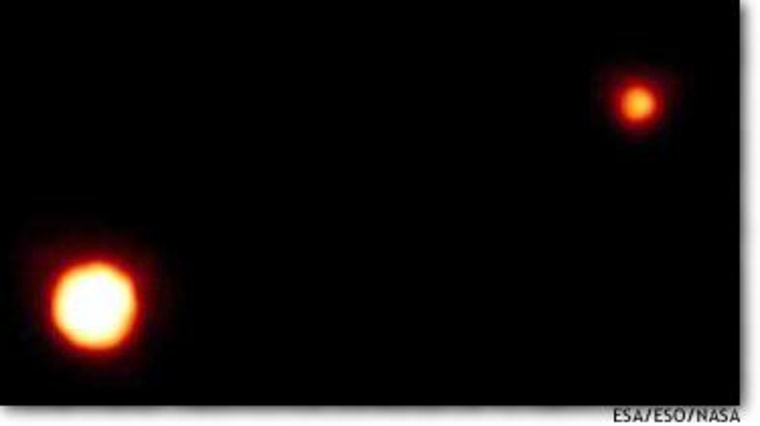After 20 years as an also-ran, humble Pluto has reclaimed its title as the solar system’s farthest planet.
Most of the time, Pluto is farther away from the sun than Neptune, its planetary neighbor. But because Pluto follows an unusually elliptical path, it passed within Neptune’s orbit on Feb. 7, 1979. As of 5:08 a.m. ET Thursday, Pluto’s distance from the sun once again exceeds Neptune’s.
It will be another 228 years before Pluto comes so close again. And that’s way too late for Richard Terrile, program scientist for the outer planets program at NASA’s Jet Propulsion Laboratory. He’s involved in planning a mission to send a probe past Pluto and its moon, Charon, sometime around 2014.
“One of the concerns we have is to get out there as soon as we can,” he said Wednesday. “The closer it is to the sun, the more atmosphere it has. Right now, it has an atmosphere and weather and everything associated with that.
“Over the next few decades that atmosphere will freeze out onto the surface as frost,” he explained. “There could be active volcanism, or geysering, or vents. We’d like to get out there while the planet is still active, while it’s still warm.”
In this case, “warm” is a relative term: Pluto is so small and far out from the sun that it’s a mere iceball, with a surface temperature colder than 300 degrees below zero. The sun’s illumination at high noon on Pluto is equivalent to what we see a half-hour after sunset, Terrile said.

Although Pluto crosses Neptune’s path twice every 248 years, the two planets’ orbits are timed so that there’s no chance of a collision. That circumstance is the key to Pluto’s survival despite its unusual orbit.
The eccentricity of Pluto’s orbit and the fact that Pluto is less than half the size of any other planet were among the factors that stirred up a controversy over its status.Over the past seven years, astronomers have discovered about 100 objects similar in composition and orbital characteristics to Pluto. These mini-worlds have been dubbed Trans-Neptunian Objects because their orbits are just beyond the orbit of Neptune. Pluto has come to be recognized as the biggest of the Trans-Neptunian Objects.
For months, astronomers debated what to do with Pluto. Should it be entered along with the other TNOs on the official list of our solar system’s “minor planets”? Brian Marsden of the International Astronomical Union’s Minor Planet Center thought it made sense to give Pluto “dual citizenship” — as one of the nine planets and as the 10,000th entry on the minor planet list. But would that be seen as too much of a comedown?
Despite Marsden’s insistence that such a step was by no means a “demotion,” his idea was quashed by the International Astronomical Union.
“A working group under the IAU Division of Planetary Systems Sciences is conducting a technical debate on a possible numbering system for TNOs,” the group’s general secretary, Johannes Andersen, said in a written statement. “Ways to classify planets by physical characteristics are also under consideration. These discussions are continuing and will take some time. The Small Bodies Names Committee of the Division has, however, decided against assigning any minor planet number to Pluto.”
Astronomers said that, at its heart, the controversy over Pluto was about the definition of planethood. Is that definition dependent on mass, or shape, or the way it behaves in a solar system? Depending on the criteria, our solar system could contain eight, 10 or even more planets.
“There has just never been a need to make that definition in the past,” said University of Maryland astronomer Michael A’Hearn, who heads the IAU’s Planetary Systems Sciences Division.
Mysterious planet
Terrile said Pluto’s true nature was still wrapped in mystery. “We do a lot of talking about whether Pluto’s a planet, whether it’s a small object, but the truth is we know very little about Pluto,” he said.
It’s the only one of the nine planets that’s never been visited by a spacecraft, he noted, and the dim observations made so far only heighten the intrigue. Pluto appears to have seasonal changes as well as an atmosphere, he said, and its surface has the second-highest contrast level in the solar system (only the surface of Iapetus, a moon of Saturn, reveals more contrast).
Charon has its own share of mystery. Spectral observations indicate that the moon has higher water content than the planet it circles, and some believe there are tidal forces at work within Charon. All that adds up to the possibility, however remote, that a liquid water ocean beneath Charon’s surface ice could harbor microbial life similar to that found around Earth’s undersea hydrothermal vents.
Terrile said these mysteries are adding to the excitement over the Pluto-Kuiper Express, a proposed NASA mission due for launch in 2004. After a decade-long trip, the spacecraft would fly by Pluto and Charon. “We’re going to be craning our necks to see both as we go by,” Terrile said.
But even Pluto, 3.7 billion miles from the sun, wouldn’t be the end of the line. The probe would continue on to explore Trans-Neptunian Objects in the Kuiper Belt, a cometary disk that extends far beyond the planets. Terrile said such “ice dwarfs” may still preserve leftovers from the beginnings of the solar system, 4.5 billion years ago.
“These are very, very unusual objects,” he said. “They may be very important in our understanding of how the planets originated.”
